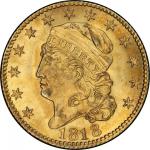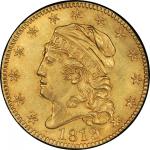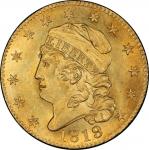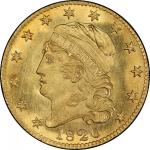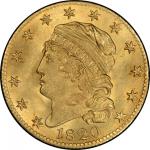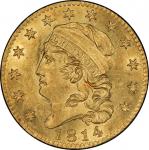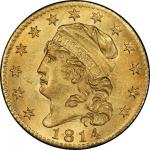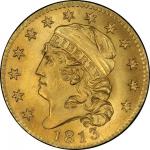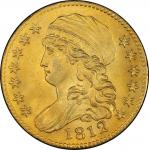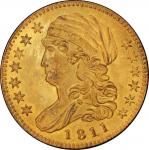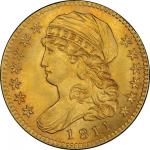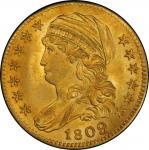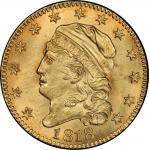“The obverse of this variety has a unique feature that is not seen on any other 1818 half eagle.” — Doug Winter, “The Half Eagles of 1818,” 2009 Highly lustrous pale yellow gold surfaces show coppery highlights, particularly in the upper right obverse periphery and along Liberty’s profile. The luster is satiny and appears especially bright against the light backdrop of the fields. Some lighter color adheres to stars 1 and 3, stars 10 and 11, Liberty’s cap above TY, and an area below the lowest neck curl. Minor lines are seen on the obverse, including a few right of star 4, but no nicks are notable. The reverse is similarly pristine. Central striking softness affects the curl in front of Liberty’s ear and the area where the upper left corner of the shield joins the wing, but all other design elements are crisply rendered and bold. An area of slightly granular planchet texture was not sufficiently struck out in the small field below the eagle’s beak. While the obverse is perfect and neither side is clashed, the reverse hosts two sizable die cracks. One nearly bisects that side, stemming from the denticles left of 5 and ending at S of PLURIBUS after following a nearly straight line that crosses the talon at left, the juncture of the shield and the wing at left, and the eagle’s neck. A crack that connects the bases of AMERICA starts quite forcefully at D of the denomination, continues with similar strength through the bottoms of ERICA, and becomes substantially thinner at AM. While this coin is described in the Bass-Dannreuther text as being clashed on both sides, no evidence of clashing is seen. Beginning in 1807, the year John Reich was hired, many obverse dies were made with an unusual punch used for the 13th star, one that shows a scallop or notch missing from one of its points. Many modern writers have attributed the peculiar 13th star to John Reich, calling it his “signature” or “secret mark,” pointing out that it did not appear until Reich’s permanent hiring. Reich left the Mint in April 1817, before 1818-dated dies were created, so the punch lasted longer at the Mint than he did. An obverse die made for 1820 dimes similarly uses the scalloped star punch for each of the 13 stars. Aside from these, and the 1818/7 half dollar, the scalloped star punch does not appear after 1815. The only 1817 half dollar die to use the scalloped star punch is the obverse of the 1817/4, which was left over from 1814. No half cent, cent, dime, or quarter made during Reich’s term of employment uses this unusual punch. If the Reich signature theory was true, it would mean that the assistant engraver produced only dies for half dollars and gold coins, while Robert Scot, his boss, accomplished all subsidiary denominations. The uniting factor of the dies upon which the scalloped star appears, putting aside authorship for a moment, is value: it appears exclusively and uniformly on high denomination coins from 1807 to 1815. The peculiar punch appears on the only quarter eagle obverse die made during his tenure, dated 1808, as well as every half eagle obverse from the introduction of the Capped Bust in 1807 to 1815. It was apparently used on every half dollar obverse during the same period. If high value is the most closely correlated factor, more than Reich’s presence or absence, it may be at the heart of the explanation. Could the scalloped star punch have been an anti-counterfeiting tactic rather than an artist’s secret signature? Clearly, any explanation of the scalloped 13th star will have to assume that the 1820 dime and 1818 half eagle obverses, which use the scalloped star punch for all 13 stars, are outliers, even mistakes. The 1818/7 half dollar, which uses the punch in the usual 13th position, may have another explanation, namely, that the die was made earlier than 1817. Among the 1818 Normal Dies half eagles seen by PCGS, this is the only one graded finer than MS-63. Doug Winter cited this example in a 2009 blog post as “the finest I am aware of.” The Harry Bass Core Collection specimen is not as fine as this, and this variety is entirely absent from the National Numismatic Collection at the Smithsonian Institution. PCGS# 8119. NGC ID: 25PR.


